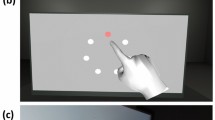Abstract
This paper outlines a study into the effects of co-location (the term ‘co-location’ is used throughout to refer to the co-location of haptic and visual sensory modes, except where otherwise specified) of haptic and visual sensory modes in VR simulations. The study hypothesis is that co-location of these sensory modes will lead to improved task performance within a VR environment. Technical challenges and technological limitations are outlined prior to a description of the implementation adopted for this study. Experiments were conducted to evaluate the effect on user performance of co-located haptics (force feedback) in a 3D virtual environment. Results show that co-location is an important factor, and when coupled with haptic feedback the performance of the user is greatly improved.








Similar content being viewed by others
References
Arsenault R, Ware C (2000) Eye–hand co-ordination with force feedback. In: Proceedings of the SIGCHI conference on human factors in computing systems, The Hague, pp 408–414
Bouguila L, Ishii M, Sato M (2000) Effect of coupling haptics and stereopsis on depth perception in virtual environment. World multiconference on systemics, cybernetics and informatics (SCI 2000), Orlando, pp 406–414
Caclin A, Soto-Faraco S, Kingstone A, Spence C (2002) Tactile “capture” of audition. Percept Psychophys 64(4):616–630
Cheng K, Pulo K (2003) Direct interaction with large scale display system using infrared laser tracking devices. In: Australasian symposium on information visualisation, Adelaide, 2003. Conferences in research and practice in information technology, vol 24
Dettori A, Avizzano CA, Marcheschi S, Angerilli M, Bergamasco M, Loscos C, Guerraz A (2003) Art touch with CREATE haptic Interface, ICAR 2003. In: 11th International conference on advanced robotics, University of Coimbra, Portugal, June 30–July 3
Dinh HG, Walker N, Hodges LF, Song C, Kobayashi A (1999) Evaluating the importance of multi-sensory input on memory and the sense of presence in virtual environments. In: Rosenblum L, Astheimer P, Teichmann D (eds) Proceedings of the IEEE virtual reality ‘99 conference. IEEE Computer Society Press, Los Alamitos, pp 222–228
Durlach P, Fowlkes J, Metevier C (2005) Effect of variations in sensory feedback on performance in a virtual reaching task. Presence 14(4):450–462
Ernst MO, Banks MS, Bulthoff HH (2000) Touch can change visual slant perception. Nat Neurosci 3(1):69–73
Frisoli A, Jansson G, Bergamasco M, Loscos C (2005) Evaluation of the pure-form haptic displays used for exploration of works of art at museums, World haptics conference, Pisa, March 18–20
Hayward V, Astley OR, Cruz-Hernandez M, Grant D, Robles-De-La-Torre G (2004) Haptic interfaces and devices. Sensor Rev 24(1):16–29
von Helmholtz H (1867) Treatise on physiological optics, vol III (English translation by Southall J, 1925)
Hoffman HG (1998) Physically touching virtual objects using tactile augmentation enhances the realism of virtual environments. In: Proceedings of the IEEE virtual reality annual international symposium’98, Atlanta, pp 59–63
Jack CE, Thurlow WR (1973) Effects of degree of visual association and angle of displacement on the “ventriloquism” effect. Percept Mot Skills 37:967–979
Loscos C, Tecchia F, Carrozino M, Frisoli A, Ritter Widenfeld H, Swapp D, Bergamasco M (2004) The museum of pure form: touching real statues in a virtual museum, VAST 2004. In: 5th International symposium on virtual reality, archaeology and cultural heritage, Brussels
Meehan M, Insko B, Whitton M, Brooks FP (2001) Physiological measures of presence in virtual environments. In: Proceedings of 4th international workshop on presence, Philadelphia, pp 21–23
Rolland JP, Biocca FA, Barlow T, Kancherla A (1995) Quantification of adaptation to virtual-eye location in see-thru head-mounted displays. In: Proceedings of the VRAIS, pp 56–66
Sallnäs E, Rassmus-Gröhn K, Sjöström C (2000) Supporting presence in collaborative environments by haptic force feedback. ACM Trans Comput-Hum Interact 7(4):461–476
Sato M (2002) Development of string-based force display: SPIDAR. In: 8th International conference on virtual systems and multimedia (VSMM2002), Gyeongju (alias Kyongju), Korea
Shneiderman B (1983) Direct manipulation: a step beyond programming languages. IEEE Comput 16(8):57–69
Shneiderman B (1997) Designing the user interface, Chapter 9, interaction devices (Sections 9.1–9.3), 3rd edn. Addison-Wesley, Reading, pp 306–327
Stratton G (1896) Some preliminary experiments on vision without inversion of the retinal image. Psychol Rev 3:611–617
Wall SA, Paynter K, Shillito AM, Wright M, Scali S (2002) The effect of haptic feedback and stereo graphics in a 3D target acquisition task. In: Proceedings of eurohaptics 2002, University of Edinburgh, 8–10th July, pp 23–29
Wallace M, Roberson G, Hairston W, Stein B, Vaughan J, Schirillo J (2004) Unifying multisensory signals across time and space. Exp Brain Res 158(2):252–258
Wann J, Rushton S, Mon-Williams M (1994) Natural problems for stereoscopic depth perception in virtual environments. Vis Res 35(19):2731–2736
Ware C, Rose J (1999) Rotating virtual objects with real handles. ACM Trans Comput-Hum Interact 6(2):162–180
Acknowledgements
We would like to thank Deepti Narwani and Emanuele Ruffaldi for their help in the current study. The work presented in this paper was partially funded by the collaborative European project PUREFROM (IST-2000-29580), a 3-year RTD project funded by the 5th Framework Information Society Technologies (IST) Programme of the European Union.
Author information
Authors and Affiliations
Corresponding author
Rights and permissions
About this article
Cite this article
Swapp, D., Pawar, V. & Loscos, C. Interaction with co-located haptic feedback in virtual reality . Virtual Reality 10, 24–30 (2006). https://doi.org/10.1007/s10055-006-0027-5
Received:
Accepted:
Published:
Issue Date:
DOI: https://doi.org/10.1007/s10055-006-0027-5




